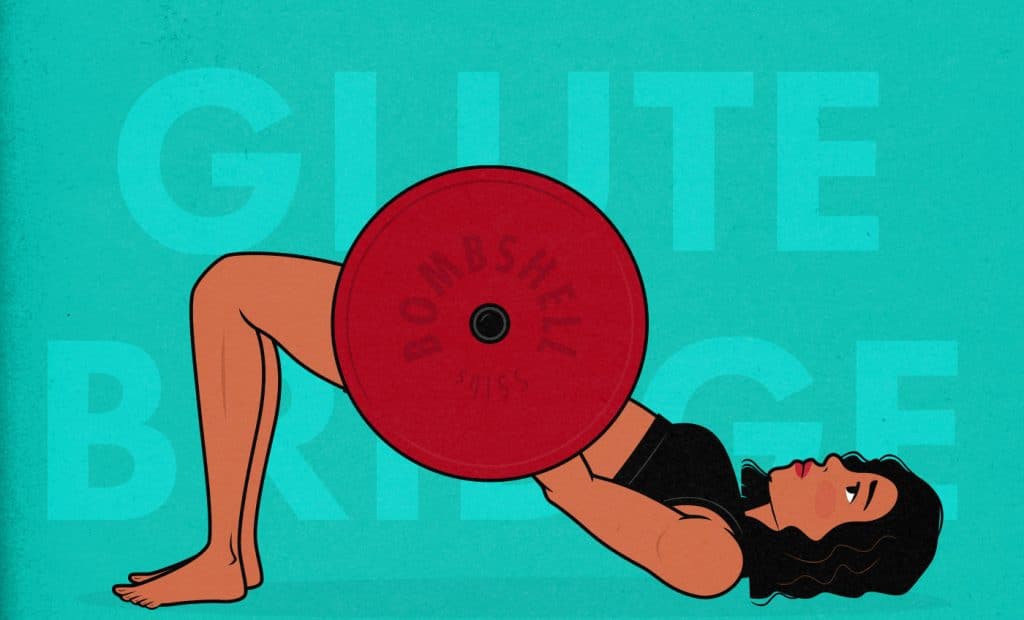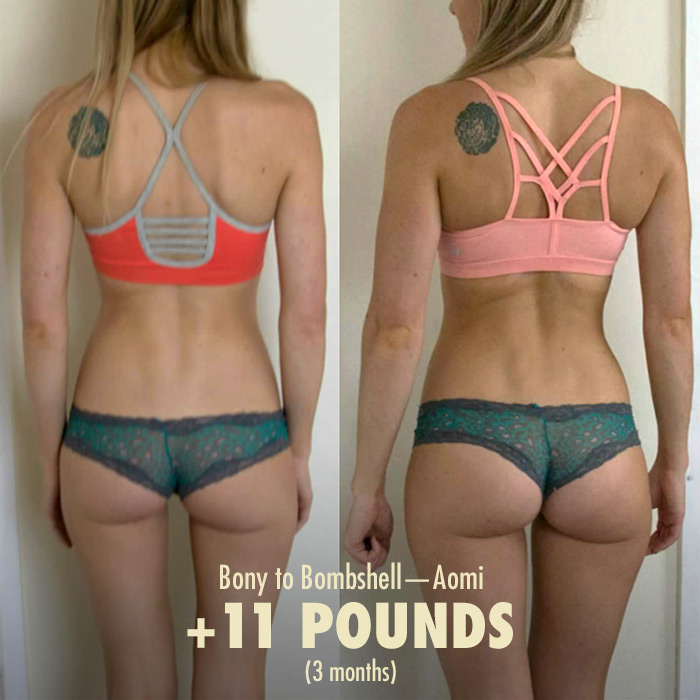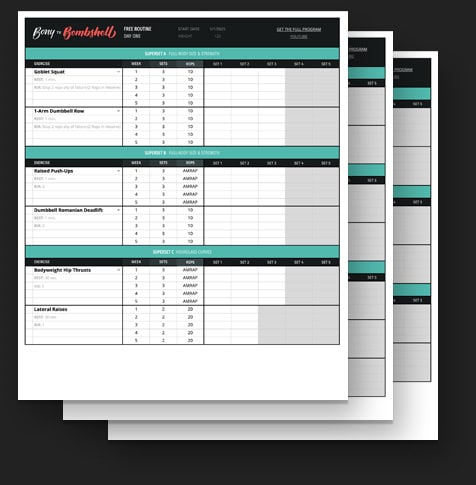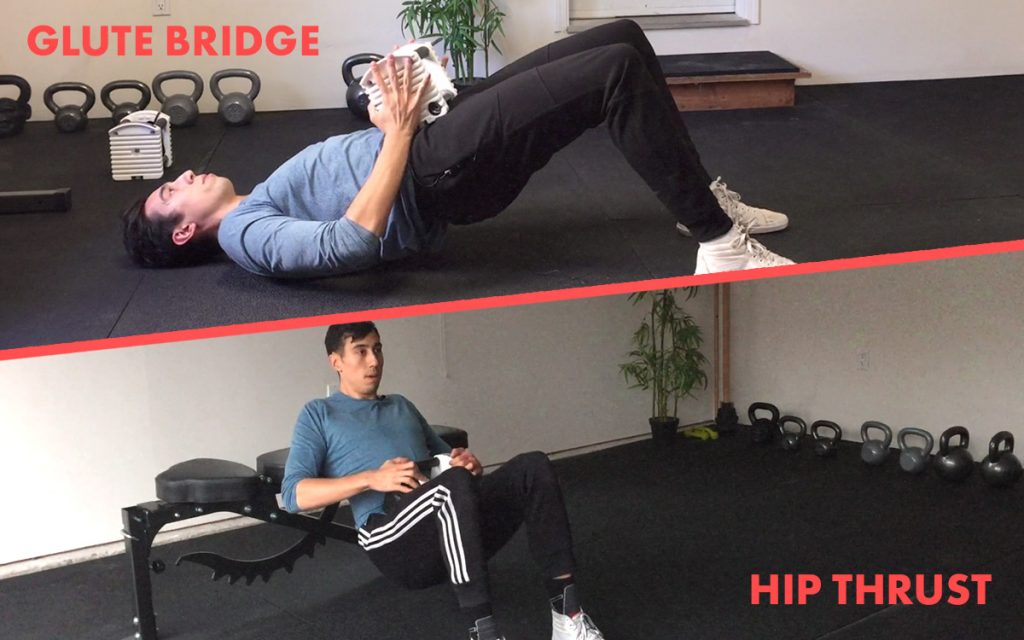
Glute Bridges For Women: Overview, How-To, & Workout
The glute bridge is one of the best isolation exercises for building a strong and muscular butt. Building up the butt muscles, such as the gluteus maximus, can help a woman improve her waist-to-hip ratio, help relieve back pain, and improve her athleticism. Let’s take a closer look.
Glute Bridges: The Overview
Benefits
The glute bridge is an isolation exercise. This means that it primarily only works one joint at a time—the hips. Because it’s not a compound exercise which works many joints at once, its benefits won’t be as extreme as something more full-body like the dumbbell Goblet squat, which hits the glutes, quads, core, shoulders, etc.
But as a precision tool, the glute bridge is incredibly powerful because it allows you to effectively isolate the glute muscles, allowing you to gain butt muscles fast. This can be handy for a number of reasons.
- Improves glute strength and size. As a glute isolation exercise, this exercise effectively loads up the glutes with a lot of weight and in a safe manner. Not only is it a low-skill exercise with less chances to get injured, but it can be loaded up with a lot of weight easily. What this means is that doing progressive overload, slowly increasing strength time, is easily done. Just pop another weight plate on. That will make muscle growth in the glute area straightforward.
- Minimally hits the quads and hamstrings. One of the main reasons females might use the glute bridge is because it hits the glute muscles without excessively hitting the quads (front of thighs) or the hamstrings (back of thighs). Sometimes when someone has squatted too much, their front thighs explode in size, sometimes making their butt look small. Or sometimes they’ve done too many Romanian deadlifts and had a hard time activating their glutes, and their hamstrings dwarf their glutes. The glute bridge can help isolate the glutes, allowing you to specifically stimulate just that one area, helping to improve balance (or even to create emphasis.)
- It can help teach glute activation. Many women struggle with something called gluteal amnesia or “dead butt syndrome,” which means they have a hard time using their glutes properly. There are probably a lot of reasons for this (Low-rise jeans? Sitting too much?). A whole generation of us has somehow lost the ability to bend at the hips and instead bend with our backs. Anyways, sometimes when a woman starts squatting and deadlifting, they have trouble activating the glutes properly. Their quads and hamstrings like to jump in more than they should. That means the thighs blow up in size, and injuries might be more likely. The glute bridge can help someone learn what it feels like to work the gluteal muscles and help get those strong enough to jump in with other exercises.
- It can help a woman look more feminine. Sexual dimorphism is the term used to describe the differences between males and females. Structural differences in the bodies are a huge part of those differences. Men have an innate drive to have a thicker neck, wider shoulders, and stronger arms for protection and capacity for violence. For women, there is a common drive to have a lean and cinched-in waist with wide hips, which correlates with fertility health. Research has shown that women store omega-3 type fats (such as from fish) on their hips, which is necessary for building a baby’s brain, and both women and men pay attention to this without even knowing why. Aside from glute fat, glute muscularity (and leg muscularity) is another sign of good general health. Using glute bridges can help give some attention to the area and brings heightened blood flow for healing and recovery, helping to improve the female physique.

Muscles Worked
The glute bridge is an isolation exercise that mainly works the glutes such as the:
- Gluteus Maximus. The gluteus maximus is the largest and strongest of the glute muscles, and it has the most potential to grow. Its main job is to thrust the hips forward, and that makes the glute bridge an excellent exercise to grow the maximus. Because the maximus is so large, for the best shape, it’s best to try and use a variety of exercises to hit both the upper and lower fibres of it. As you can probably guess, that means doing a variety of squats, deadlifts, and hip isolation exercises like the glute bridge.
- To a lesser extent, the gluteus medius and minimus. These two glute muscles will get worked a bit with the glute bridge. But they mainly help to move your legs away from your body and to rotate them, so you will want to hit these other glute muscles with a compound leg exercise (like squats/deadlifts) and then some isolation work (like clamshells and side leg raises, etc.)
Types Of Glute Bridges
The glute bridge is a very simple movement, but there are several variations based on how you add weight to your body and how you position your legs.
- Bodyweight glute bridge. The bodyweight version is a good one for women to start with at home if they’re a beginner and don’t have experience with lifting weights. Your glutes are surprisingly strong, though, so don’t be surprised when you outgrow the bodyweight version quickly.
- Single-leg glute bridge. The single-leg version can effectively add more weight to your glutes without changing the actual weight by removing one leg from helping to lift. If you’re doing bodyweight, this is a good way to keep progressing without using any weights. When things get too easy, just do one leg at a time. If you’re using a dumbbell at home and you’ve run out of weights and can’t load it up heavier, doing single-leg dumbbell glute bridges can help you keep progressing forward again for a little while.
- Dumbbell glute bridge. This version is when you use a dumbbell (or kettlebell). Lay down right next to it, and shimmy it onto your hips to make the glute bridge more challenging. This is a good beginner variation for most women.
- Barbell glute bridge. This is a great intermediate and advanced lift for women. You’ll need a barbell, Olympic plates, barbell clips, and a pad of some sort to protect your hips from the barbell. Our Bony To Bombshell members are often glute bridging 225–315 pounds by the end of the program, which is why they have such crazy glute before-and-afters. Their glutes have become fearsomely strong.
- Feet-elevated glute bridge. In this version, you place your feet/heels on top of something, like a bench or a couch. What this does is increase the range of motion, and it turns the glute bridge closer to the hip thrust movement. This means it’ll be inviting more hamstrings into the exercise, which might be desirable based on your goals. But it’s hard to load up with a lot of weight, so it’s not used too often.
How To Do The Glute Bridge: Video Demonstration
Here’s Marco coaching Marielle on how to do the 3 variations of the exercise:
- Dumbbell glute bridge
- Weight plate glute bridge
- Barbell glute bridge
Glute Bridge Proper Form Breakdown
- Set up the barbell with an appropriate weight or get the dumbbell you’re using and place it next to where you’ll be lying down to do the exercise. If you’re in the gym, a lot of women prefer to set up near a wall, with their feet towards the wall, for more privacy.
- Lay down on your back, bend your knees, and bring your feet up closer to your butt in a comfortable position.
- Roll the barbell up to your hips, and place a pad between the pad and you. Or if you’re using a dumbbell, shimmy the dumbbell onto your lap.
- Take a deep breath in while holding the weight, thrust your pelvis forward and squeeze your glutes.
- Breathe out in a controlled manner as you squeeze and lift.
- Don’t overextend your back. Only go as high as your hips naturally let you.
- Control the weight as you lower your hips back down to the floor.
- As your hips rest on the floor, that completes the rep.
- Do as many reps as it says to do on your workout.
Common Mistakes With The Glute Bridge
- Choosing too light of weight. Your glutes are strong. Surprisingly strong. Women often outgrow the bodyweight version quickly. Even dumbbell versions are outgrown fast. For the barbell glute bridge, you’ll need at least enough weight to get the barbell to the right height that you can slide under, which is usually two 45-pound plates on each side with the 45-pound barbell. But you might find that even 135 pounds is too light. When the weight is too light, sometimes it allows your form to be a bit wonky since the weight doesn’t demand perfect form. Don’t be surprised that when you find the right weight, your form cleans up a bit.
- Overextending at the top of the lift. Sometimes, when you’re new to the exercise, and you haven’t gotten into a groove, you might try and go up too high. Some women look in the mirror and think they haven’t lifted it high enough, and they try and get an extra inch or two higher, and they aren’t getting this range from their hips but rather from extending their lower back. This will put a lot of strain on the low back. If you find this happening to you, just focus on squeezing the glutes. You don’t need to lift the weight that high to get good muscle growth. Work within the range you have.
- Not breathing! Too many women hold their breath and bang out tons of reps and wonder why they feel so lightheaded after this one. Take a breath in, breathe out as you contract your glutes, and breathe in as you lower the weight. At the very least, you should be doing a full breath in between each rep, depending on how you like to brace if you’re glute bridging serious weight.
Using Glute Bridges In A Female Workout
Use A Lower Rep Range
In research, to optimize for muscle growth and muscle size, you want to choose a weight that you can do 4–40 repetitions with. The sweet spot for glute bridges, though, is on the lower rep range of around 5-7 reps. The main benefit of this isolation exercise is that you can load up the barbell with a serious amount of weight and fatigue those glutes. You can do the high-rep glute work with harder-to-load exercises like donkey kicks, clamshells, etc.
If you find yourself not able to do 5 reps, use a lighter weight. If you can do more than 10 reps, use a heavier weight. That will guarantee that the workout is helping you gain both muscle size and muscle strength and not making endurance adaptations.
Challenge Yourself But Stop Short Of Failing
Ideally, you’ll stop your glute bridges when you’re just about to fail, but you could still do a couple of reps more. But if you’re a beginner, it’s hard to know exactly how hard you’re pushing yourself. If you aren’t sure if you’re taking your sets close to failure, try doing more reps. Try pushing yourself all the way until you can no longer do any more glute bridges with perfect form. That way, you’ll know what it feels like. You might be surprised that you were a lot stronger than you thought. Next time, stop right before that point of failure.
Start With Two Sets, Then Add More
Start with just a couple of sets, then over time, add more sets as you get stronger. We recommend doing two sets in the first week. Practice your form, find the right weights, and take your time learning the glute bridge.
Next week, if your glutes, hip bones, and low back aren’t too sore at the start of each workout, try adding a set to each exercise. If that goes well and you feel ready for more, add another set next week. You can do around 3–6 sets per exercise. Most women will do best with 3–4 sets. If you ever start to feel worn down, or if you’re coming back after a long break, start the cycle over again, going back to just two sets and rebuilding from there.
Rest 1-2 Minute Between Sets
How long you rest between sets of glute bridges isn’t that important. Whether you rest for 2 minutes or 10 minutes, you’ll still stimulate a similar amount of muscle growth. The important thing is that you rest long enough to catch your breath, ensuring that your cardiovascular system doesn’t limit the performance of your muscles. We want to challenge your glute muscles, not just your heart (though your heart will get a good workout, too!).
The main reason to rest for just a couple of minutes is to keep your workouts shorter. You don’t want to spend all day in the gym. But if you need more rest or get interrupted partway through your workout, no problem. Just pick up where you left off.
If you want to blast through your workout even faster, you can do the lifts in a circuit/superset. Do a set of glute bridges, rest a minute, then do a set of raised push-ups, rest a minute, then do your second set of glute bridges, and then do your second set of raised push-ups. That way, you’re still giving different muscle groups plenty of time to recover between sets, but you’re doing another exercise during the rest period.
Free Routine For Female Beginners: Glute Emphasis With Full Body Workout: Includes The Glute Bridge
If you don’t have a workout, you might be interested in our full Bony to Bombshell program. A sample beginner’s workout for women that includes glute bridges could look like this:
- Dumbbell or Barbell Glute Bridges: 2 sets of 7 repetitions.
- Raised Push-Ups: 2 sets of as many reps as you can.
- 1-Arm Dumbbell Row: 2 sets of 10 repetitions.
- Dumbbell Goblet Squats: 2 sets of 10 repetitions.
- Lateral Raises: 2 sets of 10 repetitions.
- Bonus Glute Work: 2 sets of Dumbbell Romanian deadlifts, clamshells, hip thrusts, donkey kicks, etc.
GET THE free GOOGLE SPREADSHEET OF THE
female BEGINNER’S FULL-BODY with glute targeting WORKOUT

Get the glute targeting workout as a Google spreadsheet. You’ll be able to pick from exercise alternatives, and fill out the sheet.
Plus, we’ll make sure you’re on the Bony to Bombshell newsletter, and send you all of our best women's muscle-building content.
Q&A About The Glute Bridge
Q: How heavy should I glute bridge?
A: In general, you want the barbell to be the right height, so you need the tallest Olympic plates, which are generally 45 pounds each. So at a minimum, most women will need to be glute bridging 135 pounds (45-plate x 2, and a 45-pound barbell). If that sounds like a lot, the barbell brings stability, so you might be surprised that you’re stronger than you think. But if that seems too heavy, start off with the dumbbell variation. You can start off real light, like 10 pounds, and then gauge how easy it is for you. Just treat too light of a weight as a warm-up set. We are all starting off with different levels of strength.
Q: How long do I hold the glute bridge at the top?
A: You don’t need to hold it. The main muscle growth will come from working the muscle in its full range of motion—not just holding the top. So just do the reps in full control (lower it slowly with intention, and explode with power when you lift your butt off the ground), and you’ll be good.
Q: How often should I be glute bridging?
A: That depends on your goals, but we’re also big fans of this lift, so it’s one we include in the Bombshell programming a lot, so we might be a bit biased. If you want to master it, you can do this one every workout, realistically.
But if your goal is just to get general glute growth, you’ll want to pair that exercise with other lower-body exercises for balanced growth. Think of things like dumbbell goblet squats, dumbbell Romanian deadlifts, clamshells, etc.
Q: Can I glute bridge at home?
A: Of course. Some women have bought a barbell, a barbell bad, and Olympic plates for home use so they can master the glute bridge (and hip thrusting) with privacy. No squat cage is needed.
But if all you have is a kettlebell or dumbbell, you can use that too to get started. Then graduate to a single-leg dumbbell glute bridge if needed.
Q: What is the difference between glute bridges and hip thrusts?

A: According to most EMG research which measures muscular contractions (which should be taken with a grain of salt), hip thrusts activate our glutes better than glute bridges do. So, someone might ask, “why would you ever do a glute bridge if it’s inferior at stimulating the glutes? Plus, the hip thrust has more range of motion, which is good for muscle growth.”
Still, we include the glute bridge in our own program for a few reasons. Why?
- Progression. Glute bridges are easier to learn. The first reason is progression. Many women don’t have the core control to do the hip thrust without disconnecting their ribs from their pelvis. That means they’ll probably feel a lot of pain in their back instead of a burn in their glutes. This increases the risk of pain and won’t stimulate the glutes properly. So we teach a simpler progression first: the glute bridge. This allows someone to roll the weight over their hips, get into position, and just push. Simple. And their form will get more locked in over time, allowing them to progress to the hip thrust.
- Heavier Loading. The second reason that glute bridges can be helpful is that you can load them up with a much heavier weight because the exercise uses a smaller range of motion. This means you can glute bridge far more weight than hip thrust. This can be an excellent way to add safe ultra-heavy lifting to your training. Powerlifters use this trick all the time by doing partial squats, rack pulls, etc.
- More Glute Isolation. The third reason is that compared to hip thrusts, glute bridges are far better at taking the thighs (quads and hamstrings) out of the picture. So even though it might activate less of the glutes objectively per rep compared to hip thrusts, it also isolates the glutes better.
- Do Both Exercises For More Variety for Your Glutes. Variety helps to fill in any muscular gaps. This will ensure that you’re growing all of the muscle fibres that run through your hips, including all of the fibres in your glutes and the myriad of other muscles in your hips. The takeaway is that your training program has a place for both glute bridges and hip thrusts. Whether you’re a beginner or an advanced lifter (or somewhere in between), this remains true. The only change will be how much you’re lifting.
What Next?
If you liked this article, you’d love our muscle-building newsletter. We’ll keep you up to date on all the latest muscle-building information for women. Or, if you want us to walk you through the process of building muscle, including teaching you the lifts, giving you a full workout program, a complete diet guide, a recipe book, and online coaching, check out our Bony to Bombshell Program.



FREE women's Muscle Growth MINI-COURSE
Get our 5-part female bulking mini-course that covers everything you need to know about:
Here are some related articles